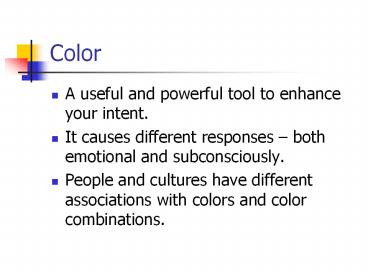Color - PowerPoint PPT Presentation
1 / 24
Title:
Color
Description:
Color A useful and powerful tool to enhance your intent. It causes different responses both emotional and subconsciously. People and cultures have different ... – PowerPoint PPT presentation
Number of Views:147
Avg rating:3.0/5.0
Title: Color
1
Color
- A useful and powerful tool to enhance your
intent. - It causes different responses both emotional
and subconsciously. - People and cultures have different associations
with colors and color combinations.
2
The Color Wheel
3
Hue
- Hue refers to the name of a color.
- Example
- Blue
- Blue-Green
- Yellow
- Etc.
4
Intensity
- The colors quality of brightness and purity.
- High intensity
- When a hue is strong and bright
- Low intensity
- When a hue is faint and dull
5
Pop art began in the 1960s. It was an
international art movement
6
Andy Warhol and Roy Lichtenstein were Americans
and Claes Oldenburg was born in Sweden
7
Primary Colors
- Red, yellow, and blue.
- They are mixed to make all the other colors but
they cannot be made by mixing other colors.
8
The Pop in Pop Art is short for popular or
popular culture
9
Common Color Associations For Holidays
- Valentines Day Red, White, and Pink
- St. Patricks Day Green and Gold
- 4th of July Red, White, and Blue
- Halloween Orange and Black
- Hanukah Blue and White
- Christmas Green and Red
10
Pop artists used images from popular culture and
created images for popular culture like album
cover art
11
(No Transcript)
12
Andy Warhols studio was called The Art Factory
13
Color and Moods
- Color can effect moods
- both
- physically and emotionally.
14
(No Transcript)
15
Secondary Colors
- Orange, green, and violet.
- They are located midway between the primary
colors on the wheel. - They are made my mixing two primary colors.
16
Tertiary Colors
- By varying the amounts of the two primary colors
used, it is possible to create number of these
intermediate hues. - These colors are found between the primary and
secondary colors.
17
(No Transcript)
18
Complementary Colors
- Colors that are opposite to each other on the
color wheel.
19
Complementary Colors
- There is NONE of the complements color in one
another. - For example there is no green in red and no red
in green. - The addition of only a small amount of a hues
complement lowers its intensity. - So a green can be made to look less green and
move by degrees closer and closer to a neutral
tone by the addition of its complement red.
20
Analogous Colors
- Colors that are next to each other on the color
wheel and are closely related. - Traditionally, there are three in an analogous
set. - You choose one and the two next to it complete
the analogous color set.
21
Warm Colors
- Reds, Oranges, and Yellows
- They are vivid in nature.
- They are bold and energetic
- They advance in space.
- You do not want to overwhelm your content with
eye catching hues. But if you want something to
stand out you should use a warm color.
22
Cool Colors
- Blues, Greens, and Violets
- They are soothing in nature.
- They give an impression of calmness and rarely
overpower the main content or message of a
design. - They tend to recede.
- If an element of your design needs to be in the
back ground, one should use a cool color.
23
Monochromatic
- All tints and shades of a color or hue
24
Stare at the image for 5-10 seconds and then look
at a white board or wall. What do you see?































